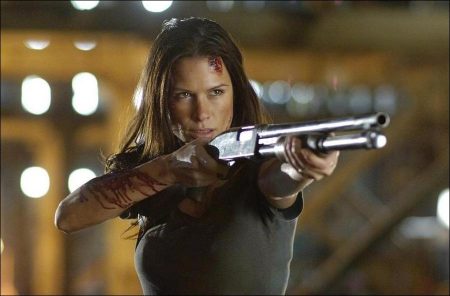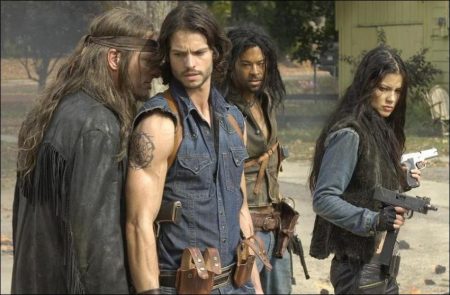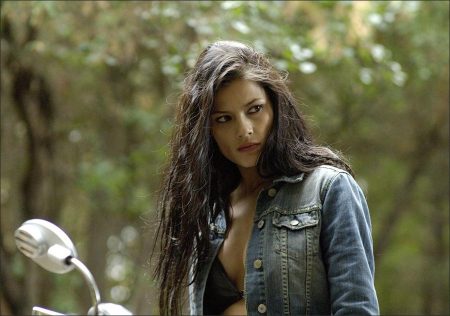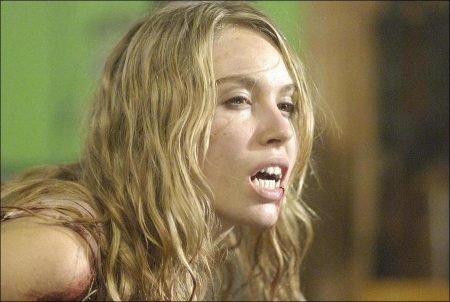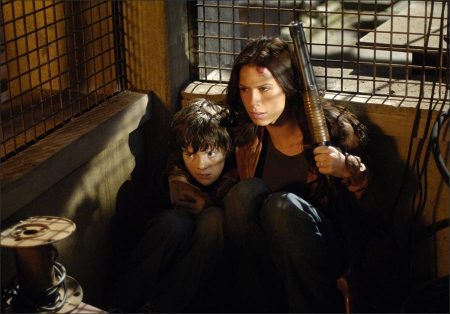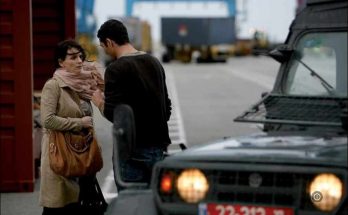Tagline: For them to live, we must die.
Two packs of Skinwalkers, creatures who, based on Navajo mythology, possess the power to change from human to werewolf, move at lightening speed and can kill with curses, watch the night sky as a blood-red crescent moon rises. Bound by blood, divided by principles, and hell bent to survive, this moon signals to each pack the coming of an ancient prophesy. In the small town of Huguenot, Timothy (Matthew Knight) approaches his thirteenth birthday, unaware this marks the time of his transformation.
His mother, Rachel (Rhona Mitra) believes her son’s health is deteriorating, but those around him, who’ve guarded him since birth, know the boy is a half-blood and when the red moon is full, he will assume the unique power to control the destiny of his family. They also know that Timothy’s gift puts his life in grave danger.
Without the guidance of a father, Timothy has been raised under the vigilant eyes of his grandmother, Nana (Barbara Gordon), Uncle Jonas (Elias Koteas), his cousin Katherine (Sarah Carter), and her boyfriend Adam (Shawn Roberts).
They have protected him as much from those who want him dead as from themselves, for with every full moon, they change to werewolves. But they have found a way to resist the searing urge to stalk prey, knowing the curse remains incomplete without the taste of human blood.But there are other werewolves who have embraced their bloodlust, reveling in the immortal freedom of their bestial incarnation and prepared to do battle to preserve their way of life.
Led by Varek (Jason Behr), Zo (Kim Coates), and Sonya (Natassia Malthe), the peace of Timothy’s life is savagely shattered as the violent feud pits brother against brother, lover against lover, and good against evil. Under a full moon, their bloodline leads them into a battle for possession of the boy who holds the key to their survival.
Skinwalkers: The Mythology
The cult of the wolf spans centuries and continents, appearing as far back as the Greeks in Arcadia who worshipped Zeus Lykaios with a sacrifice of human flesh mixed with that of a wolf. Whoever ate the flesh was condemned to become a wolf, unable to change back for eight years. Feared and hated, even Aesop’s fables written in the 6th century BC, portrayed the animals as the embodiment of evil and deception.
By the Middle Ages, the demonization was widespread. Wolves were believed to be in league with the Devil, possessing the dark powers of the supernatural world. Throughout Europe, legends sprang up about men transforming into bloodthirsty man-eating wolves on the full moon, roaming forests, attacking at will. So feared was the wolf that by the Middle Ages, they had been hunted down and slaughtered, driving them towards extinction in the British Isles and Western Europe.
Across the ocean, the indigenous peoples of North America embraced the wolf as a noble animal symbolizing the spirit of freedom balanced with fierce loyalty to the pack. Native Americans revered the ancient spirit of the wolf because both were hunters who provided for their families. This creature was a medicine animal, a personal totem, and the power of the wolf was a gift.
Medicine men used it for healing mind, body and spirit, but the witches of the Navajo tribe wanted the power for their own use. By the light of a full moon, they’d drape themselves in the skin of a wolf and transform, complete with incredible speed, strength and stealth. By morning, they regained human form. The Navajo called them Skinwalkers or Yenaldlooshi, which translates to, “He who trots along here and there on all fours.”
At first, the transformation could be controlled, but terrible power coursed through their veins. Many could not control their lust for power and the thrill of the hunt, and soon Skinwalkers could not fight the beast within. With every full moon, the change happened again. It became a curse, passed on through birth or a Skinwalker bite that drew blood.
Skinwalkers split into two groups: those who seized the life of a wolf, reveling in the bloodlust, and those who rejected it, knowing that until they tasted human blood, the transformation would be incomplete. It was this last group who believed in the prophesy that if a half-blood child, the offspring of a human and a Skinwalker, lives to be thirteen, a red moon will rise, boy will realize the power to end the curse.
About the Production
“We are beginning to think our director, Jim Isaac, is either a skinwalker himself or just really wants to be one,” says Producer Dennis Berardi, who together with Isaac, have been shepherding the SKINWALKERS script from the beginning four years ago.
The script began with an idea rooted in Navajo mythology from screenwriters Todd Harthan and James Roday created in 1999. “The idea of Skinwalkers earthy, dusty and went back to the grassroots of the myth, literally and figuratively,” said Roday. “It was far away from the Goth influences of other creature features and the storyline wasn’t predicated on the one sequence of changing from man to beast. It focused on the struggle of what it meant to be a wolf on a person by person basis.”
They pitched it to screenwriter James DeMonaco, and then it eventually found its way to Jim Isaac. Once in his hands, the script took on the same power as a wolf’s skin draped over a man – Jim was possessed by the story, the characters and the creatures. He stayed with it, finding the right producers, building the dream until it became reality.
In the same way the writing team of DeMonaco, Roday and Harthan found their director, Jim Isaac found a champion and a kindred spirit in Producer Dennis Berardi. Both Isaac, with his extensive background creating special effects for David Cronenberg, and Berardi, the founder and head of Mr. X, a world-class digital studio specializing in feature film visual effects and animation, have an insatiable appetite for genre films.
“We’re big thriller/horror effects fans,” says Berardi. “Jim and I always talked about SKINWALKERS being a beautiful movie, and I saw it in my head as a very open film, very iconic with the two primary themes of good vs evil as the character battles against their inner beast intertwined with the classic mother-son story. I just loved the richness of this story, the classic themes and the very personal character struggles. In addition to that is that my entire career and my company, Mr. X, is based around visual effects. I always pictured a beautiful red moon so Jim and I formed a production company and named it Red Moon after prophetic image in this film.”
“It’s taken about four years, trying to get all the pieces of the puzzle together,” explains Jim Isaac. “SKINWALKERS was one of the first scripts I’ve read that kept me completely engrossed. It had everything I wanted in a film and a story – it has special effects, it has great scares, it has a great story, the characters are rich and full, the relationships are true. It’s about something more than just a scary movie.
Dennis Berardi and Jim Isaac then took the project to the powerhouse producer in Canada, Don Carmody, to whom the potential of the story as well as the concept was plainly evident. “This is a modern day retelling of the Skinwalkers legend with a post-modern Western motif,” Carmody explains. “Vampires have been done to death. Skinwalkers and werewolves have gotten a bad shake. I wanted to see something that wasn’t a teen comedy or something where they weren’t subservient to any other creature. I brought Stan Winston on board because I thought if anyone was going to create creatures that I wanted to see, and I didn’t want to see big dogs, he was the man to do it. Having worked with Stan for decades, I knew he was as much a fanatic about the skinwalker idea as I was. I wanted to keep the magic, not to go over the top with effects that no one would believe are possible.”
Carmody, who is in his third decade in the business, having produced more than 80 films including Silent Hill, Resident Evil, Resident Evil: Apocalypse and Wrong Turn, knows the market. When considering Isaac as the director, Carmody said, “Jim has a tremendous amount of experience with visual effects. While he’s a new director, he’s got years and years of experience working with the masters of the genre. SKINWALKERS has been his picture from the beginning. I listened to his vision and checked out his credentials, and I was confident he could pull this one off.”
Executive Producer Robert Kulzer had previously worked with Carmody and Berardi on Wrong Turn, Resident Evil, and Resident Evil: Apocalypse and has also made a name of himself in genre filmmaking. He read the script and by the time he reached the scene of the shoot out on the streets of Huguenot, he was in. “I think whenever society is in difficult times, and private lives are overwhelmed by current events, movie audiences turn away from reality as a form of entertainment. Being drawn into another world is the only explanation that I have for the sudden popularity of movies about zombies, vampires and axe-wielding murderers. When the rules of good and evil go out the window in the real world, they come back in genre movies. There is a kind of morality involved which empowers moviegoers by saying, if you follow these rules, you’ll have a good ending.”
For Kulzer, the key to a successful horror movie is character and casting. “I believe very, very strongly that in successful genre movies, you need a female lead. This works on subconscious sexual level. It’s more fun for an audience to see a woman scream than to see a man scream. I think there is more satisfaction for an audience when a vulnerable woman is overwhelmed by a situation and then ultimately rises to the occasion and beats the crap out of the bad guy. A male lead makes it very hard to create a believable threat or believable obstacle because, it’s almost ingrained into our movie experience that, okay he’s going to have to kill a few people in the process, but ultimately he’s going to win. It’s still less common to have a female lead, but audiences suffer more with your lead character that way.”
For Director Jim Isaac, this movie is simply about Skinwalkers and the beast that lurks inside everyone. It is an exploration of the dark side of every personality, the moral choices we make each time we are confronted with the opportunity to indulge ourselves. To illustrate the two sides, the story focuses on two kinds of people: the kind who embrace the freedom to live exactly the way they want to live, doing what they want to do, and the other kind of people who choose the moral high road, fighting their desire, choosing to not succumb to the animalistic urges of being Skinwalkers. ““I love Skinwalkers because there’s a sexuality about them, an animal, a primal passion that I think we everyday just try to hold in. Being a beast is really what we want to be at times, and Skinwalkers get to do that.”
The Contemporary Interpretation of the Skinwalker Myth
“Our interpretation is based on the Navajo legend of the Skinwalker which is literally that certain people had the gift to walk with the beasts at night,” said Berardi. “Skinwalkers are able to become animals in spirit, understanding them fully in their naturalistic state and to walk with them and change their skin to become like them. So the legend was partially spiritual, but also partially a transformation that happens as well. The werewolf legend is based, not necessarily on the Navajo legend, but it’s in similar in mythology where there’s the beast within us. We generally have the choice to suppress the beast and be more moralistic or embrace the beast and do whatever we want. The legend is very romantic in as much as it, again connects with the humanistic struggle of morals. The cool thing about our SKINWALKERS movie is we’re really going to test the audience; the audience is going to want to be these creatures. These guys drive Harleys, wear leather, eat, drink, and have sex whenever they want; I mean it’s a very appealing temptation.”
Casting
“It was about finding an ensemble that clicked,” explained Isaac. “The people that we have responded to the script passionately. Elias Koteas was one of the first actors I approached years ago. Rhona Mitra blew me away with such an articulate, intelligent, passionate view of who Rachel was. Jason Behr is unbelievable. All three of them just light up the screen. It’s great to work with real actors, who are passionate about it, who are prepared, who understand the material, who are willing to talk about it. Sarah Carter playing Katherine, is a brilliant young actress. All of them, from Natassia to Shawn, Lyriq and Tom, the whole cast comes to it with a desire to do their best work and bring something to the table. I couldn’t be happier with them.”
The Naturalists – Wolves Gone Wild
To the last one, ever actor in the large ensemble of SKINWALKERS was ecstatic about the story, their character and the process. The `Pack of Four’, Varek (Jason Behr), Zo (Kim Coates), Sonja (Natassia Malthe) and Grenier (Rogue Johnston), were Skinwalkers who embraced their inner beast to the fullest extent of their nature. Behr’s character is the leader of his tribe, the alpha male and to prepare, he studied wolves themselves. “Understanding the pack dynamic was important. I followed the work of Jim and Jamie Dutcher, the filmmakers who spent six years living with Sawtooth Mountain gray wolves. These animals are stunningly beautiful,” observed Behr. “You hear so many evil things about wolves, but if you look closer, they are very much about loyalty and family and protecting each other.”
Not satisfied with being at arm’s reach, Behr made his way to the Toronto Zoo to have a little face time with his role models. “Skinwalkers are not werewolves. It’s human nature versus wolf nature – two very different things. While it was sad to see wolves in captivity, it strengthened my belief in Varek viewpoint – confinement is the same thing as denying who and what you really are. It’s wrong. Varek had two lives: before becoming a skinwalker and then living as one. Rightly, he thought that if you haven’t felt, seen, tasted what Varek had, how could Jonas’group say that it’s wrong. This character is very sexy and alluring, something I could really get my teeth into.”
Varek’s right hand man is Zo, the beta wolf, played by Kim Coates. Coates slipped into his character with all the noise and bluster of a man (in an Easy Rider fringed leather jacket) on a Harley. “Zo is like Waylon Jennings on wolfbane. Varek has a pair of Desert Eagles, but Zo is packing a double barrel, sawed off, pump-action 12-gauge shotgun, a Colt 45 and a big knife. He’s the oldest of the bad wolves and he sees the curse as a gift.” Coates is one of those actors who likes to act from the inside out. That took on new meaning with the first camera test of the Stage 4 Skinwalker makeup, “It was unbelievable to watch myself transform. I really could not get over the face Stan Winston has created for me. I was totally wolfed out,” he recalled. “I’d test myself in the mirror, my cheeks would move, my eyes could deliver, they lifted my face, it was just narly! “
No pack is complete without a female and Varek had Sonja, played by Natassia Malthe, an actress who has acknowledged that she often gets the part of the tough chick. “I’m the thorn in Varek’s side as well as his lover. Rachel, his wife from his former life, becomes the `other woman’ and that makes this whole thing very personal for me, not just a quest to find the boy.”
Behr laughs when he thinks about the nature of Varek’s relationship with Sonja, “When it came to wolf relationships, like with Sonja, well, if you think it’s bad as humans, throw in some fangs and a tail and it’s all out the window.”
Malthe enjoyed the experience as much as her character Sonja did, “We’re like wild cowboys. If I was a Skinwalker, this is exactly the kind I would be. It’s got to be every girl’s fantasy to ride a Harley, wearing tattoos and black leather with wild hair flying behind you. I even wore my costume to a bar and some guy from a bike gang went ballistic, thinking I was the real thing.”
The fourth member of the pack is the mute omega wolf, Grenier, played by newcomer Rogue Johnston. It’s Grenier’s falcon that leads the pack to their young prey. Johnston, who had dressed as a werewolf every Halloween since he was a child, felt it was destiny to get this role. “Grenier’s a twisted soul, partly because he had his tongue ripped out. But he has to find Timothy because, like the rest, he’s not willing to give up the power of being a Skinwalker. We’re not reanimated corpses like vampires or zombies. We’re alive, living, breathing gorgeous creatures. The idea of crossing a wolf and a man is exotic.”
The Humanists – Wolves at Bay
The centerpoint of the humanist pack is Elias Koteas as Jonas, the alpha male of a very different breed of Skinwalker. Together with his daughter Katherine (Sarah Carter), her boyfriend Adam (Shawn Roberts), Nana (Barbara Gordon) and Doak (Lyriq Bent), they are bound by the collective abhorrence of their own inner nature that causes them to become wolves every full moon. With the help of Will (Tom Jackson), a Native American human, they resist the transformation, binding themselves into pods that prevent them from going on the hunt. This is their secret as well as the impetus to protect Jonas’ 12 year-old nephew, Timothy and his mother, Rachel, played respectively by young Matthew Knight and Rhona Mitra. With Timothy’s 13th birthday a few days away, the community sees the red moon rising over their small town of Huguenot, heralding the prophesy that a half-blood male, the offspring of a human and a Skinwalker, should he reach the age of thirteen, will have the power to end the curse.
Koteas went deep to find the soul of Jonas. “Some days I’d work from simple things: my awareness of heat or of the hair on the back on my neck standing up. The sensory level is the only way to approach Jonas, otherwise it’s too intellectual.” The degree of concentration fascinated Koteas. “What is Jonas? A human? An animal? This other being is an albatross, like an addiction. Jonas wants comfort, needs relief. He is a loving, spiritual human whose energy is directed towards the divine to get past the needs of the body, yet he can still hear a hawk’s heartbeat.”
Koteas believed that Jonas is devoted to protecting what could be the salvation of the cursed, but the cost is high. “The family element, my daughter Katherine, the boy Timothy, my commitment to them, that exciting in the script. There’s a moment during the first transformation in the RV, when Timothy sees what I really am – it was such a human moment. That, and the self-sacrifice for the greater good is so human, so profound. That’s what captured me.”
At the heart of the prophecy is young Timothy. Up until this story begins, he suffers from asthma-like attacks that get worse the closer he gets to his 13th birthday. Eventually, Timothy realizes this is a battle going on inside his body, the Skinwalker versus the human. This is a demanding role for an 11-year-old actor, but one he was thrilled to accept, “There’s something amazing about discovering your father is a wolf.” A die-hard horror fan, he sees this as a coming-of-age story that takes place in a hail of bullets. Knight is also very pleased that his setting a precedent because this is the first time in the genre for a kid to be a Skinwalker. “This is my first horror/action movie and it’s awesome with all the guns. I had to go through gun training because at the end of the movie, I get to shoot Sonja.”
Timothy’s mother, Rachel, is played by Rhona Mitra who describes her maternal role as innate and predetermined by circumstance. “Having lost her husband to the Skinwalkers, she must now protect her son from all that the legacy represents. She’s a victim of sorts because she was crippled by the loss of her love. To play this role, your gut instinct just takes hold. She has one goal and that’s to protect her child.” For Mitra, this makes her uniquely objective among the other characters, free of the temptation and the bloodlust. Yet it pits the maternal instinct against the instincts of the Skinwalkers. “Rachel undergoes a transition and developmental change: mother to warrior.”
Supporting Timothy and Rachel are family members dealing with their own struggles. Katherine, Jonas’ daughter, is a young woman who exemplifies the giving, selfless human condition, but when captured by Varek’s pack, she begins a transition into the selfish, carnal Skinwalker existence. Actress Sarah Carter sees Katherine as someone discovering herself, as many 23-year-old women do, but at hyperspeed because the sexual power of a woman that age is a force of nature. When Varek turns Katherine, she tries to pull Adam, her boyfriend with her. “This story is a chance to go from a place that’s human and tangible to the animal extreme,” says Carter. For her, it’s not just another horror movie. “SKINWALKERS is a metaphor for what it is to be human and have desires and then fall into those cravings.”
Shawn Roberts, hailed as the new `horror hunk’ by the genre press, is Adam, a good guy through and through. “The life we have is intense: our daytime existence is rewarding, but when the moon comes up full, we feel the curse taking hold. We have a responsibility to strap ourselves in,” explains Roberts. Another devout horror fan, Roberts is just as happy watching them or acting in them. “Love `em! Plus, for my whole life, people tell me I have wolf eyes. That is my animal, so now I am a wolf, I have gunfights, I have stunts. Being in SKINWALKERS is a dream come true.”
Supporting the family is Doak, played by Lyric Bent. Doak, another reluctant Skinwalker, is a local mailman by day. “He’s dedicated to Timothy, comforting him in his illness because he knows the boy is the answer to the curse. Doak’s also willing to give up his life to protect him when Varek’s gang comes to Huguenot. He’s a compassionate, Skinwalker-next-door type, but he does go postal when Timothy is threatened. ”
Rounding out the community is the Native American Will, played by Tom Jackson as Will, who in reality is actually a member of the wolf clan. Will offers guidance to Jonas’ pack, aware of Timothy’s heritage, yet is part of the conspiracy to keep the truth from Rachel. “There’s a trilogy of themes: good, evil and motherly instincts. Working with Rhona has been wonderful because her delivery is always consistent and that gives this story a sense of reality,” said Jackson. “Wolves are a threatened breed. There is a very loyal element to their world driven by strength more than anything else. If I was a Skinwalker, I’d try desperately to remain a wolf – not try to be human at all. There is a magical excitement with humans when they relate to wolf power.”
Stan Winston Studios meets Mr. X
“I truly believe this is best skinwalker script I have ever read,” said Stan Winston. And to that end it afforded Winston the opportunity to create a skinwalker that he had always wanted to see. “I’ve been a werewolf fan for as long as I have been a fan of movies and that’s been my entire life. I have watched recent attempts at werewolves using extensive animatronics and extensive digital effects and what has happened is that they lost the humanity of the creature.” Turning to the fantastical computer-manipulated man-beast portraits by artist Daniel Lee, Winston found his inspiration. Less beast is more. “For me a skinwalker is still a man, a wolf-man, a wolf on two legs.” For Winston, it was paramount that the creature be character driven and so he halted the transformation so that, visually, it was possible to still see remnants of humanity. “I wanted to give the performance back to the actors,” he continued. “So I’ve created skinwalkers that are the most beautiful creatures I have ever seen. I’m in awe ever time I look at them.”
John Rosengrant and Shane Mahan headed up Stan Winston’s creature team. “Shane and I have always loved werewolves,” said Rosengrant. “But up to now, Hollywood has pushed their design so they look like long-snouted dogs. What we’ve done is to create a wolf-man with a practical application of prosthetics and then Dennis Berardi’s special effects studio, Mr. X, subtly augments it with CG to widen the eyes and tilt them up, creating a triangular face shape. The results are profound, imperceptible, and terrifying.”
Extensive work went into the look of the Skinwalkers, incorporating the Navajo myth that each person retains his humanity while at the same time acquiring the strength and speed of the wolf which meant the prosthetics had to survive strenuous practical application.
The process began by bringing the actors to Stan Winston Studios in Los Angeles (a trip each actor treasured because it was an occasion to see Winston’s iconic creatures dating back to Aliens). There, complete body casts, including a dental casting and contacts lens specifications, were made. Building the Skinwalkers was a complex effort involving teeth which would permit actors to deliver lines without affecting their speech, contact lens mimicking the eyes of real wolves, paws and claws which would allow for using guns as well as doing stunt work, and extensive fur-covered body and facial prosthetics that didn’t hinder or mask the expressions of the actors. Winston’s philosophy was to avoid impenetrable makeup that forced actors to be twice as big in their performance just to get half as much on the screen.
“This film has allowed us to advance the craft of creature makeup because we are not relying on animatronics,” explains Shane Mahane. “Our team, which consisted of approximately twenty artists in LA and nine on set, spent months devising the look of these wolves, taking notes from Daniel Lee’s work as well as from Henry Hull in the 1935 film, Werewolf of London and Lon Chaney’s Wolf Man. We used thin layers of silicone on the face and because the actors could see themselves transforming in the mirror, testing the latitude of how their expressions still read, it made them feel better, more connected to the creatures they became. ” There are four stages of transformation, the last of which required four hours of application.
Mahane continued, “The look of the teeth and the look of the eyes are pure wolf, big round yellow or green eyes, darker around the edges. The front teeth have been shortened and the two upper canines are extremely long with the two lower teeth on the lower jaw. The fur, all woven on by hand, was largely human hair, mixed with yak.” In keeping with the animal kingdom where the male is more flamboyant, Sonja was to be less muscular, more delicate, yet still menacing. Her fur was a fairer color, using angora, which Natassia Malthe would adoringly stroke, calling it “Prada fur.”
The Skinwalker Style
The Western thematics in SKINWALKERS is a fresh take on an ancient legend, a concept appreciated by Costume Designer, Antoinette Messam, Production Designer, David Hackl, and Stunt Coordinator, Steve Lucescu.
For Messam, SKINWALKERS was going to be a departure from the trend of slick, industrial, highly stylized vampire films. Her designs blended with Hackl’s rural sets and allow for the `High Noon in the Skinwalker Corral’ shootouts and wirework choreographed by Lucescu.
Messam’s starting point was post-WWII America and the birth of the Hells Angels. “Jim and I connected on the imagery in the book, “Bound for Glory.” The look was to be gritty and rural, with softness around the edges. Heavily distressed leathers and expensive denim added an outlaw component to match the Harleys the Pack of Four rode. There’s also a strong element of Easy Rider in the designs. There’s almost no black and no long trenchcoats. These were travel-weary, hardened, sexy wolves whose clothes said `Look at me! I’m a bad ass,” without showing excessive skin. I wanted a piece of animal on Sonja -fur was the answer. Skinwalkers are not afraid of fur.”
For their transformations, the designs had to allow for broader shoulders, more muscular thighs and wider chests. Varek wears a vest, as does Grenier and with Zo, the jacket just slips off. In the case of Jonas’ transformation, his increased size shreds his shirt and we have several versions of that shirt, depending on what stage he is in. A subtle, but intriguing design element is the jewelry. Messam worked with designer Dana Schneider (Matrix , X-Men) to create astonishing necklaces, rings and belt buckets featuring a crescent moon.
The costume design segued seamlessly into David Hackl’s sets. For Timothy’s town of Huguenot, Hackl recalls, “Plate shots wouldn’t cut it. We wanted to bring the town to life. For this, we found Creemore, Ontario, nestled into rolling hills and the autumn leaves were on fire with color. Creemore has one crossing guard, a barber and one baker. The wide shot of Varek’s motorcycles approaching town is an absolutely classic.”
The final fight takes place in the Hearn Power Plant on the shore of Lake Ontario. “It’s an 160 foot tall old art deco structure with a towering smoke stack in a state of semi-demolition. And the inside looks like a bomb went off,” Hackl details. But his favorite set is Jonas’ RV. Originally scripted as a Winnebego, Hackl spotted an old six-horse wagon. JimJim loved the idea of an animal carrier. “We ended up piecing one together from four or five different trucks. We have a fantastic welding team and a great scenic team who painted it. Set dressing and props added the pods where Jonas’ pack strap themselves in at night. It’s a character in itself.”
The stunts of Steve Lucescu are based on the idea that whatever a human can do, a Skinwalker can do better. “We take the Skinwalker legend to a whole new level. We looked at the ability of an Olympic athlete in terms of running and jumping, and multiplied that by a factor of three. Their actions are all fast and high velocity.”
The big surprise was Jason Behr. “Every time I’d teach him something, he’d come back the next day and do it even better than the day before. We’d joke that he was secretly practicing because he was absolutely incredible. I set up one sequence where Varek lands on Jonas, strikes, and leaps up 15 feet behind him, then leaps down and strikesJonas again. Jonas strikes back and sending Varek flying. He did all it all in one shot, wearing the prosthetics, the teeth and the claws.”
Isaac also wanted Lucescu to have Varek’s group on motorcycles, so all four actors learned. “Jason already knew how to ride and is an absolutely phenomenal rider so we gave his a Harley called a Nasty Boy, and Rogue was familiar with dirt bikes. Natassia has to learn from scratch and did a great job.”
Skinwalkers (2007)
Directed by: Jim Isaac
Starring: Scott Anderson, Jason Behr, Lyriq Bent, Sarah Carter, Kim Coates, Barbara Gordon, Natassia Malthe, Tom Jackson, Rogue Johnston, Matthew Knight, Lyriq Bent, Shawn Roberts, Jessica Huras
Screenplay by: Tony Giglio
Production Design by: David Hackl
Cinematography by: David A. Armstrong, Adam Kane
Film Editing by: Allan Lee
Costume Design by: Antoinette Messam
Set Decoration by: Christina Kuhnigk
Art Direction by: Anthony A. Ianni
Music by: Andrew Lockington
MPAA Rating: R for violent content throughout and language.
Studio: Lionsgate Films, After Dark Films
Release Date: August 10, 2007
Views: 81
